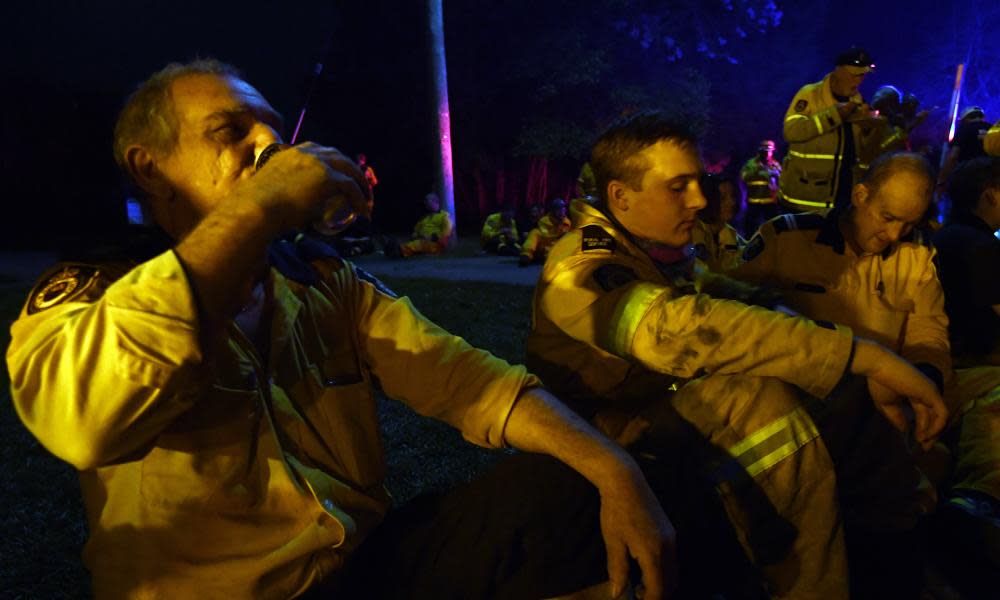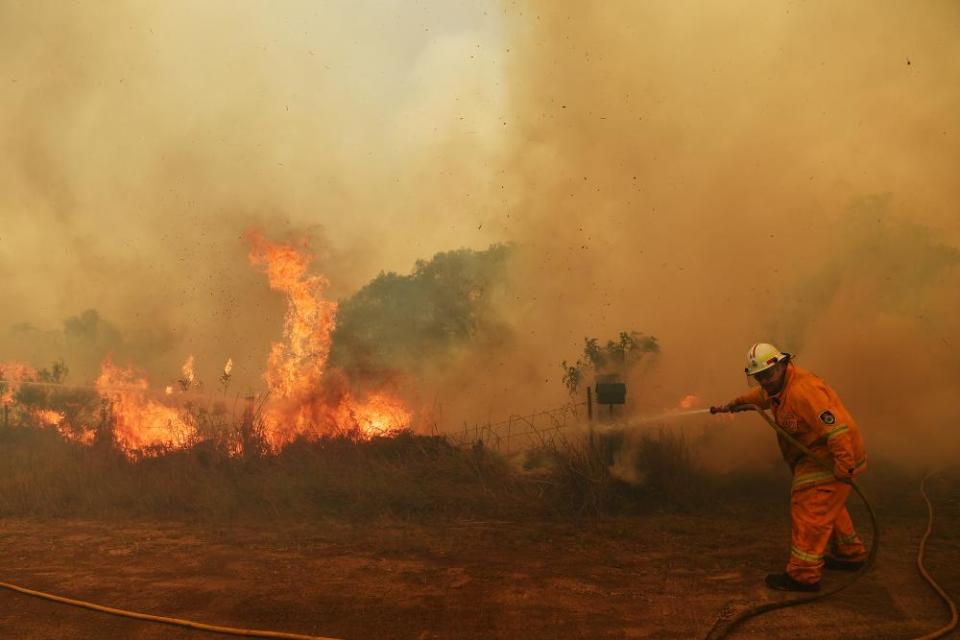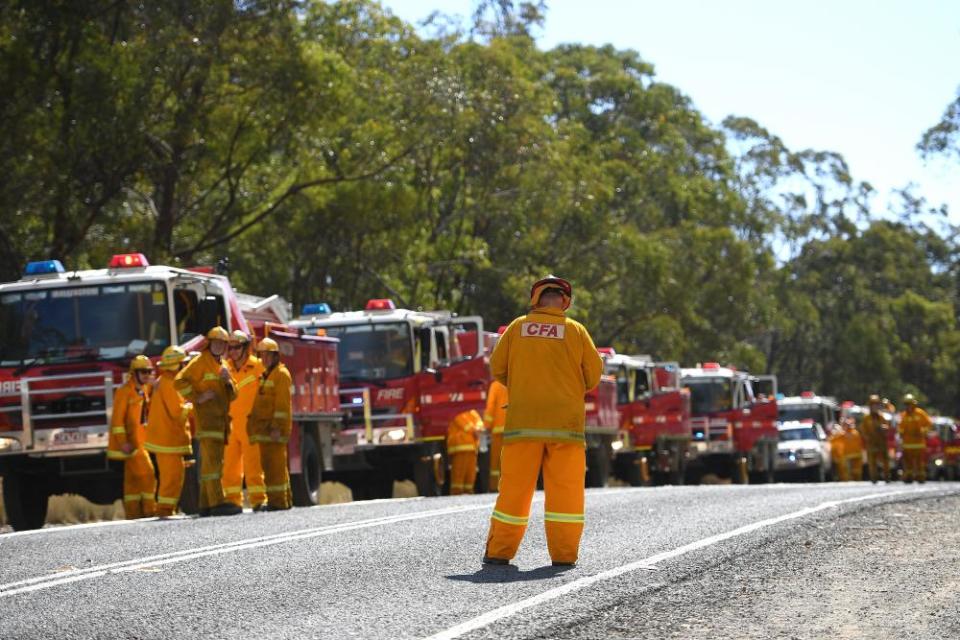'Victoria isn't burning, but it will': Australia's fire chiefs fear fatigue will take terrible toll

When Ned Haughton wrote emotionally of the terrible events in Bobin, north of Taree, earlier this week, it wasn’t only his neighbours, picking through the charred remains of their homes, who were stretched to the limit..
“I saw firefighter friends who I’ve known for years, still working after a few hours’ rest following 36 hours of chaos,” Haughton wrote, even before Tuesday’s “catastrophic” day of bushfire threat to NSW.
The ferocious and alarmingly early Australian bushfires are taking their toll on firefighters, with growing concerns about fatigue and mental health – and little sign of rain in the coming months.
The chief executive of the Australasian Fire and Emergency Service Authorities Council, Stuart Ellis, says the extension of the bushfire season both in time and in geographical spread is ringing alarm bells for the people entrusted with co-ordinating emergency response and looking after the welfare of the fire fighters.
“It’s been relentless for the last couple of months. Queensland still has fires when historically it has not occurred. NSW has had fires for two months already with a real sense of fatigue – not exhaustion, but certainly fatigue.
“We would usually see a break in the winter and people go back to their farms and their jobs – because the vast majority are volunteers. This spring we have not had a break and the predictions are that we won’t get one unless it rains. That’s the concerning thing.”
In recent days, crews in New South Wales have been supported by 350 fire personnel and 76 vehicles from Victoria, where the bushfire season has not yet kicked off. Overseas firefighting aircraft are due to arrive this weekend.
Ellis says fire chiefs are concerned about the strain on volunteer firefighters who are already under stress from the devastating drought in northern News South Wales and Queensland.
‘They don’t ask for anything’
The council plays a key role in coordinating the sharing of equipment and personnel across the states and with the northern hemisphere, mainly the United States and Canada.
By now, Ellis says, Queensland’s fire season would usually be winding down, but an absence of wet spring weather meant there were still 110 non-Queensland fire personnel helping there, including 20 New Zealanders.

With the fire season in NSW and Queensland already two months long, Ellis says many volunteer firefighters, which make up about 85% of the total emergency management workforce, are mentally and physically fatigued.
“What we are finding in rural communities in northern NSW and Queensland is [volunteer firefighters] are already stressed because of the existing drought and have a level of stress on their businesses.
“Now we are asking them to do more on the fire front. It’s certainly something we are talking about, with potential mental health issues, and the impact is something we are monitoring very carefully.
This spring we have not had a break and the predictions are that we won’t get one unless it rains
Stuart Ellis
“We have to maintain this now and we have to maintain that rate of effort for another four months and that’s a huge ask.
“They don’t ask for anything, but they appreciate the recognition. When there’s [media] coverage and recognition, that encourages people to keep contributing.
“What we’re missing is a break in that activity that we would normally anticipate – but there’s no indication it’s going to occur. The early onset and the enduring nature of what we are facing is pretty unprecedented.”
Rested personnel are needed in reserve

The NSW firefighting response is being supplemented with about 750 personnel from other states, including the Victorian contingent.
Victorian crews had been deployed “pre-emptively” and are now giving much-needed relief to NSW crews, Ellis adds.
There’s nothing more Australian than going over the border and helping out your mates
Neil Bibby
Neil Bibby, former chief executive of Victoria’s Country Fire Authority, tells Guardian Australia: “The issue is now coming – it’s volunteer burnout both physical and mental.
“It’s not just the impact of the fire, but it’s also the emotional impact of trying to help and not being able to help, and watching people’s homes, farms and factories burn down. That takes a toll on people.
“Australia’s volunteers are always willing to help their mates. There’s nothing more Australian than going over the border and helping out your mates. But it’s no good for Victoria if their fire season hits and everyone is already burned out.
“Right now, Victoria isn’t burning, but it will – and everyone knows it.”
He says the challenge facing planners is to balance the current firefighting needs with holding enough rested personnel in reserve to keep the effort going.
“The ability for us to get relief from other places is getting harder and harder and it’s not just the firefighters on the ground, but also the planning and logistics people in headquarters, the people at the [Bureau of Meteorology], the Red Cross, the Salvation Army – they can all get burned out as well.”
He says there would soon need to be conversation between commissioners about the current reliance on volunteers. With longer fire seasons and increased risk of burnout, the volunteers would need more support.
“It’s not just the volunteers, but we also have to think about the employers that release them.”
Getting help from overseas
Australia has long-standing arrangements with Canada and the United States to share personnel and large aircraft for fighting bushfires.

Two large air tankers have already arrived and a third – a DC-10 – will be in Australia this weekend. There are ongoing concerns that as fire seasons in the northern hemisphere and southern hemisphere overlap, this could put a strain on those arrangement.
Ellis says this year Australia has secured all the resources it asked for. While California is also experiencing another intense fire season, elsewhere in the US has been relatively quiet, he says.
“If in a future year there was ongoing demand in the US for these aircraft that [resource-sharing] might be an issue.”
Related: 'Nobody gets out without damage': what fighting fire does to the body
Former NSW fire and rescue commissioner Greg Mullins told the ABC on Thursday that more large firefighting aircraft were needed, and accused the federal government of ignoring pleas to fund them. Emergency leaders had tried to warn the government about the impending catastrophic fire season, but had been ignored, he said.
Ellis says NSW purchased a modified 737 aircraft that is now in service, and will be used alongside six other overseas leased aircraft that will be operating by early December.
“We are using 140 other aircraft in Australia so we are not relying on them alone. But they do offer a weight and speed of attack that other aircrafts can’t provide,” Ellis says.
Two personnel will also arrive on Friday, one from Canada and another from the US, to coordinate any further resource-sharing for the rest of Australia’s fire season.
“We want to be in a position where, should we need additional resources, they can be provided,” Ellis says.

 Yahoo News
Yahoo News 
